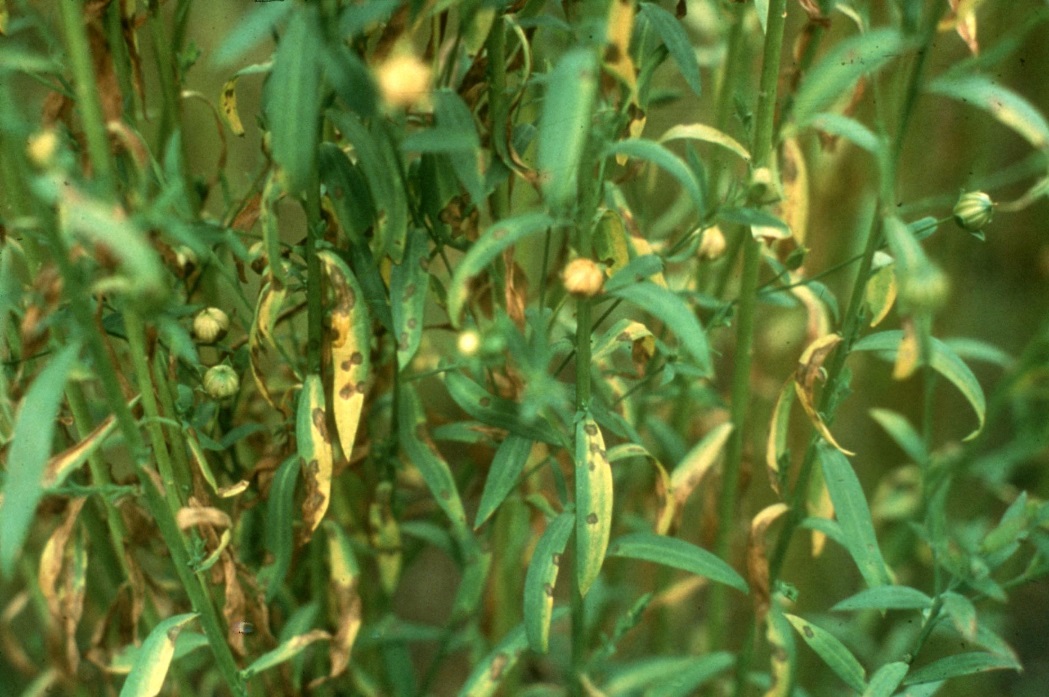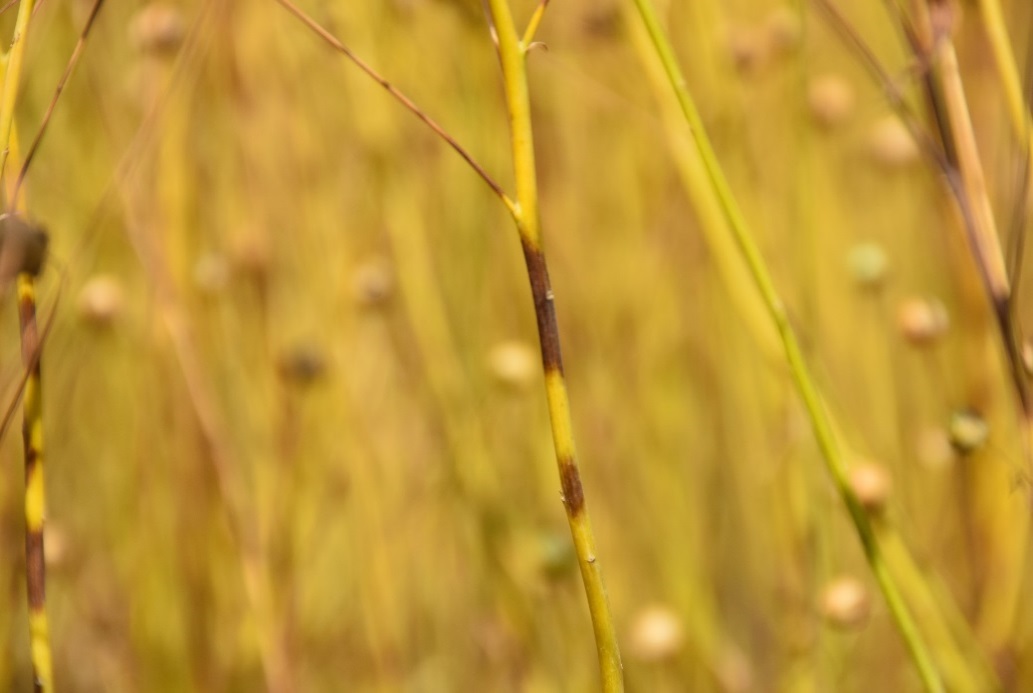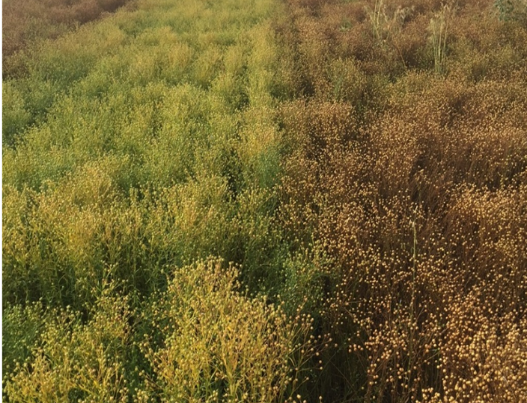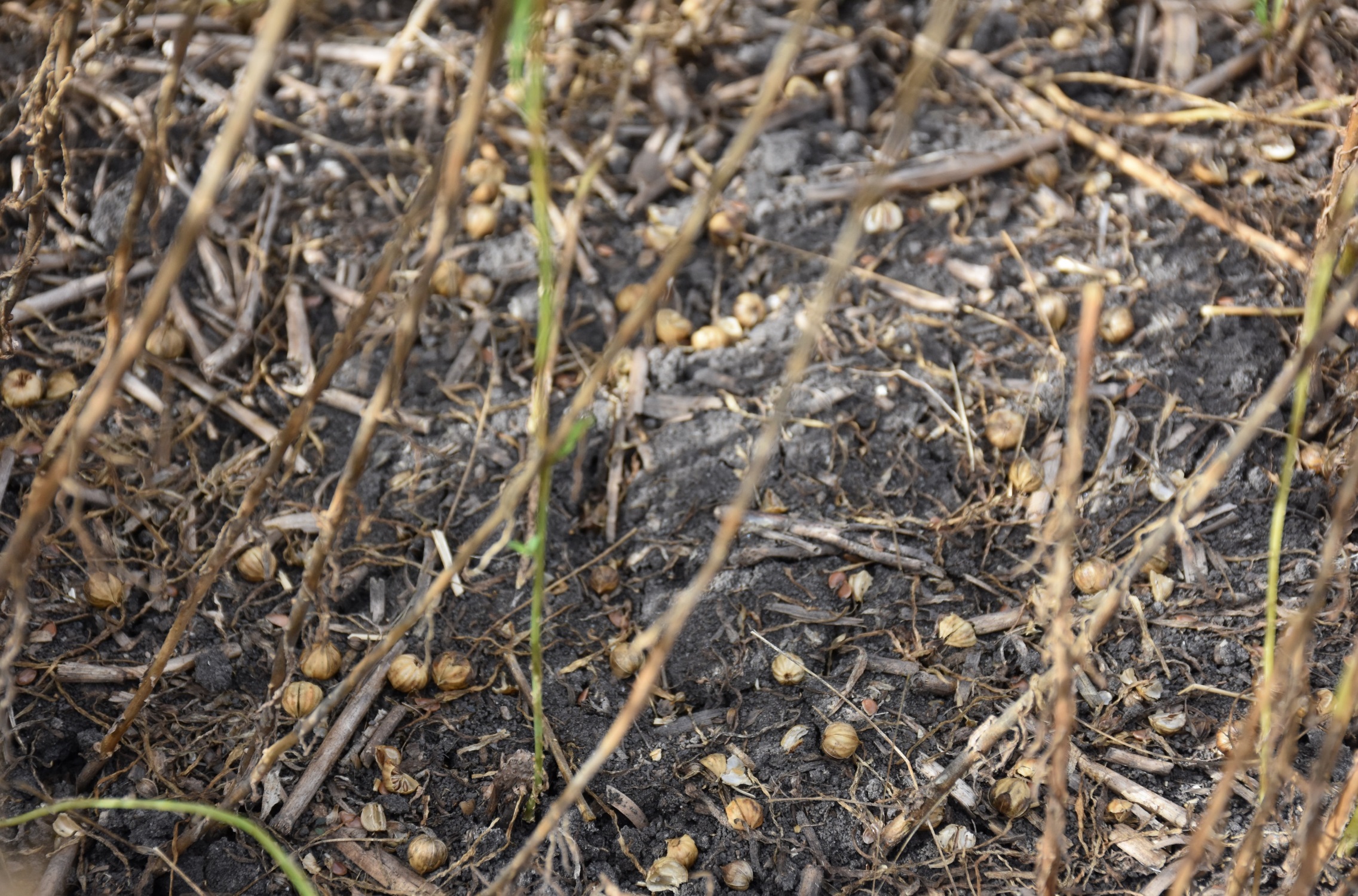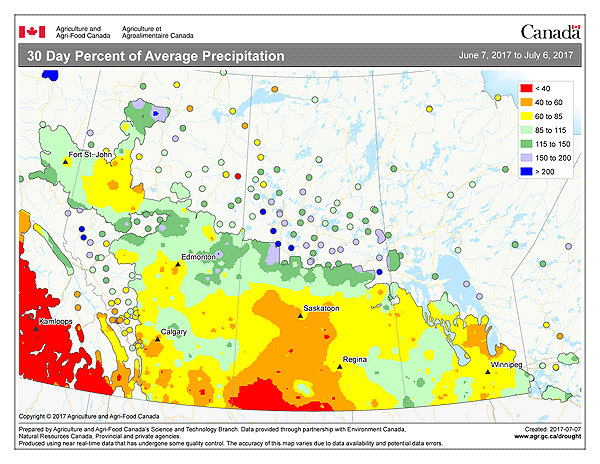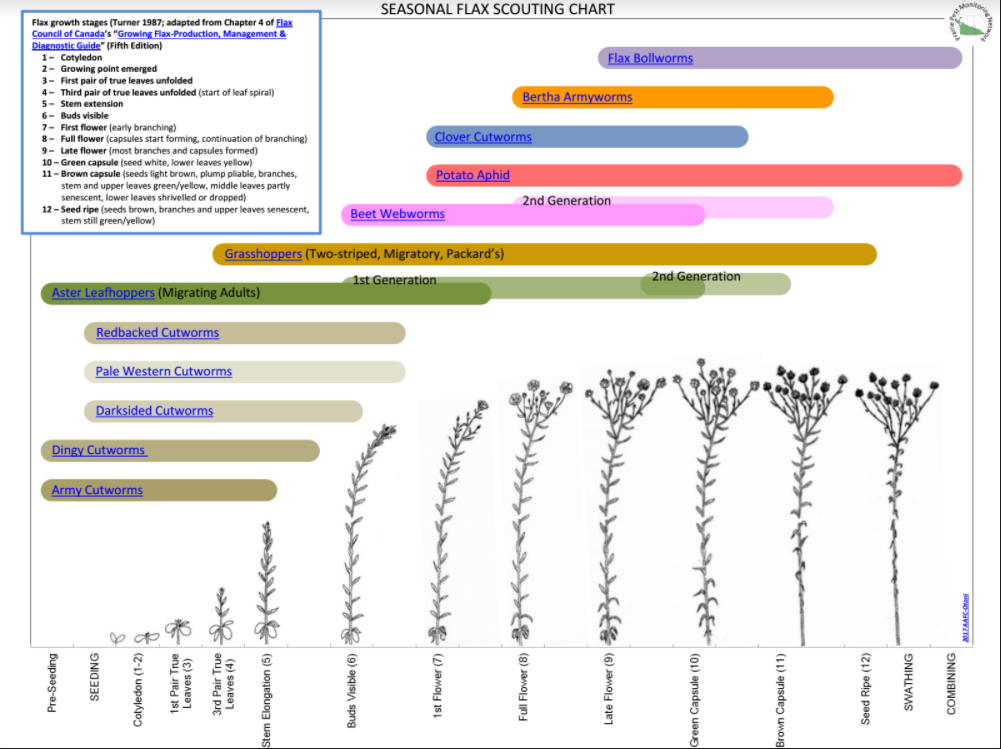Flax TIPS: July Tips: Disease and Insect Monitoring
The following highlights issues in abiotic stress, disease and insect monitoring for the 2017 growing season. Always remember, comprehensive scouting is essential for proper symptom diagnoses and to ensure appropriate action.
Impact of Heat during Flowering
Heat stress affects both pollen and ovules which lead to poor boll formation and seed set. Heat stressed flowers tend to retain petals longer and stick together, with a darker purple color. Heat stress at early flower can lead to prolonged flowering and delayed maturity. Research has shown that flowering flax can withstand 3 days of high heat (40°C), but suffered yield loss with 5 days of heat. Fewer seeds per boll, low test weights and shriveled seeds were associated with heat stress. Using historical yield and temperature data on the prairies, critical high temperatures for flax are estimated to be slightly higher than canola and wheat and similar to spring rye. June and July critical temperatures were estimated to be 35°C for flax.
Integrated Disease Management
Making a fungicide spray decision
Pasmo (Septoria linicola) generally affects almost 100% of surveyed fields every year. Pasmo is a major disease of flax, and can reduce yield anywhere from 5 to 30% or higher depending on the severity of infection. Provincial plant disease 2016 survey data (Table 1) indicates that severity ranged from 2 to 50% of stems infected. Pasmo can be an economical disease. Primary method of yield loss is boll drop from weakened and lodged plants. Table 2 shows the cost of yield loss based on a 24 bu/ac flax yield at varying levels of loss (2 – 30%) and a range of flax prices. Unfortunately, we do not have clear correlations between severity (%) and yield loss (%).
Pasmo overwinters on infected flax residues, which are the primary source of infection. For this reason, rotation is the first line of defense against this disease. Like most diseases, pasmo spreads in hot, humid conditions from the lower leaves, moving upwards and onto the stems by mid-August. However, once lesions on the stems appear it is too late for a fungicide application.
Table 1. Incidence and severity of pasmo in 81 crops of flax in Manitoba and Saskatchewan in 2016.
| Disease Classification | Fields | ||
|---|---|---|---|
| Incidence¹ | Severity² | # | % |
| 0 | 2 | 2 | 2 |
| 1 – 10 | 1 – 5 | 23 | 29 |
| 10 – 30 | 5 – 10 | 21 | 26 |
| 30 – 60 | 10 – 20 | 17 | 21 |
| >60 | 20 – 50 | 18 | 22 |
¹Disease Incidence = percentage of infected plants in each crop
²Disease Severity = percentage of stems affected by pasmo
Table 2. Cost of yield losses (2% to 30%) based on 24 bu/ac yield at varying flax prices.
| Loss based on 24 bu/ac yield | |||||||
|---|---|---|---|---|---|---|---|
| 2% | 5% | 10% | 15% | 20% | 25% | 30% | |
| Flax Price | 0.5 bu | 1.2 bu | 2.4 bu | 3.6 bu | 4.8 bu | 6 bu | 7.2 bu |
| $11.00 | $5.28 | $13.20 | $26.40 | $39.60 | $52.80 | $66.00 | $79.20 |
| $11.25 | $5.40 | $13.50 | $27.00 | $40.50 | $54.00 | $67.50 | $81.00 |
| $11.50 | $5.52 | $13.80 | $27.60 | $41.40 | $55.20 | $69.00 | $82.80 |
| $12.00 | $5.76 | $14.40 | $28.80 | $43.20 | $57.60 | $72.00 | $86.40 |
| $12.25 | $5.88 | $14.70 | $29.40 | $44.10 | $58.80 | $73.50 | $88.20 |
| $12.50 | $6.00 | $15.00 | $30.00 | $45.00 | $60.00 | $75.00 | $90.00 |
| $13.00 | $6.24 | $15.60 | $31.20 | $46.80 | $62.40 | $78.00 | $93.60 |
| $13.25 | $6.36 | $15.90 | $31.80 | $47.70 | $63.60 | $79.50 | $95.40 |
| $13.50 | $6.48 | $16.20 | $32.40 | $48.60 | $64.80 | $81.00 | $97.20 |
| $14.00 | $6.72 | $16.80 | $33.60 | $50.40 | $67.20 | $84.00 | $100.80 |
-
Early signs of infection
-
Symptoms can be present as early as the seedling stage (Fig.1).
-
Look for circular brown lesions on leaves.
-
Early season scouting should be focussed on examining leafs for lesions.
-
The fungus causes defoliation, so scouting early and frequently are important to be sure that these early signs of infection are not missed.
-
Crop rotation/ field history
-
Has flax been grown in the last 3 years?
-
Avoid adjacent fields of flax (avoid disease spread from field with flax stubble to new seedlings).
-
Has the field had previous signs of infections e.g. premature ripening, low test weights, lodging, boll drop (Fig.2) (Note that these symptoms can be described by other factors).
-
Conditions conducive for disease promotion
-
High humidity and moisture favors proliferation as spores are dispersed by rain and wind.
-
Poor weed control, higher seeding rates favors humidity.
-
Past flax crops grown on or in neighboring fields increases disease risk.
-
Weather outlook during flowering
-
Pasmo is polycyclic, meaning it can have multiple infections during the season. So weather conditions in the latter half of the growing season can also dictate the severity of infection. Scout new growth/ top of the plant after fungicide application to monitor if another application is needed. Rotate fungicides within season if using more than one application.
-
Cost effectiveness
-
Fungicide applications can be economical when yield losses exceed 5 – 10%, depending on current flax prices.
-
Development of fungicide resistance
-
Both fungicides registered for the control of pasmo in flax are in the strobilurin fungicide group. The strobilurins are rated as a “medium to high risk” of developing fungicide resistance. For this reason, fungicide applications that are applied without symptoms of the disease are discouraged.
Figure 1. (First) Pasmo lesions on flax leaves causes yellowing and defoliation. (Second) Pasmo lesions on flax stems seen as alternate banding.
Figure 2. (First) Flax with fungicide (left) and without fungicide (Right). (Second) Boll drop contributes to significant yield loss.
Most parts of the Prairies have seen below average precipitation (see below) which may have reduced conducive conditions for the disease to develop early in the season. However, high precipitation last year may have contributed to late infections, increasing the source of inoculum for 2017. Scouting early and often will be important to monitor for the disease prior to fungicide application timing. Producers and agronomists should consider the following factors when deciding to spray fungicide for pasmo.
Flax Insect Scouting – New Seasonal Flax Scouting Chart
New resources are available for producers and agronomists for insect scouting. Agriculture and Agri-Food Canada, in collaboration with industry sponsors, has launched the Prairie Pest Monitoring Network. In the blog you will find a new chart for seasonal flax scouting, which links to descriptions and management information of various insects.
Check it out here http://prairiepestmonitoring.blogspot.ca/search/label/Flax

